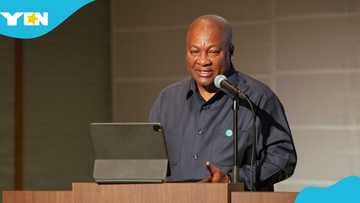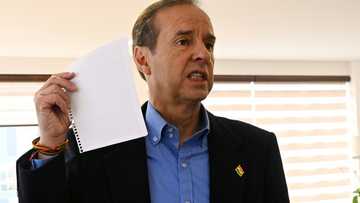UMaT Student Designs Automated Toll System, Readies for Pilot Testing Phase
- A University of Mines and Technology (UMaT) student has designed an automated toll system as Ghana readies to announce the return of road tolls
Ghana’s top stories, now easier to find. Discover our new search feature!
The government of Ghana’s quest to reintroduce road tolls has inspired a brilliant tertiary student to create an innovation aimed at making the process more efficient and seamless.
Samuel Naamgwinaa, a student at the University of Mines and Technology (UMaT) pursuing a Diploma in Electrical and Electronic Engineering, has developed an automated toll system as his contribution to Ghana’s national development.

Source: UGC
If implemented by the government, Naamgwinaa's system could make toll payments faster and more convenient for road users nationwide.
Inspiration behind NASAT E-Gate toll system
Speaking exclusively to YEN.com.gh, the 2024 Presidential Pitch winner stated that his innovation was inspired after he was informed of the government's resolve to reintroduce road tolls.
“The inspiration came when I was interviewed on Angel TV by journalist Saddick Adams. During the interview, he mentioned that the government would need a system to support the tollbooth system in Ghana. His words stayed with me, and I immediately began thinking of how to design a technological alternative to roadside toll collection that would be transparent and automatic. That single moment of inspiration gave birth to my invention, the NASAT E-Gate.”

Read also
“Ghana is your reliable gateway”: Mahama talks big as he takes 24-Hour Economy policy global
How NASAT E-Gate toll system works
Shedding more light on the system, Naamgwinaa explained that the NASAT E-Gate is designed to fully function as an automated toll system.
With this, road users will no longer need to hand cash to toll collectors at every point, but rather use electronic cards or digital methods to automatically pay tolls.
“The NASAT E-Gate is an electronic tollbooth system. Instead of drivers stopping to pay cash, they simply present an RFID card, Yagana card, or in the future their Ghana Card. The system reads the card, automatically deducts the toll fee to the government account, and then opens the gate to allow the vehicle to pass. It integrates RFID/NFC technology, a servo-controlled gate, and mobile communication through modules that can send transaction records or SMS receipts.”
The 26-year-old noted that his primary goal in developing the system was to enhance revenue collection.
“I chose to focus on this invention because toll collection in Ghana has faced challenges such as revenue leakage, corruption, and traffic congestion. By automating the process, the government can collect tolls directly and more efficiently, while drivers experience faster and smoother road travel. This invention is not just about technology but also about building trust, reducing waste, and improving national revenue collection.”

Source: Facebook
Expansion plans for students' automated toll idea
Naamgwinaa stated that his long-term goal was nationwide deployment of the NASAT E-Gate, complemented by advanced features including mobile applications and real-time reporting tools.
“My goal is to scale the NASAT E-Gate into a nationwide automated toll system, integrated with the Ghana Card for direct revenue collection. I also plan to enhance the system with mobile app integration, real-time government dashboards, and stronger hardware to withstand long-term roadside operation.
"At this stage, I am seeking partnerships with government agencies such as the Ministry of Roads and Highways and private stakeholders to pilot the system. I am also open to collaborations with NGOs and tech organisations to refine the system and ensure it meets international standards.”
Who is automated toll creator Samuel Naamgwinaa?
Naamgwinaa first gained national recognition in 2024 when he won the Presidential Pitch with the Smart Switch, a system designed to conserve electricity.
He credits his drive to develop further innovations to winning the programme and has since created other solutions, including a smart drying bed for farmers.
“Winning the Presidential Pitch gave me national recognition and proved that my ideas have value. It has boosted my confidence as an innovator and opened doors to funding, mentorship, and partnerships. It also gave me a stronger sense of responsibility to continue inventing solutions that benefit Ghana and Africa.
"In the next five years, I see myself leading Naamgwinaa Technologies as a recognised innovation hub in Ghana, with products like the NASAT E-Gate deployed across the country. I also envision my inventions improving lives in agriculture, transportation, and energy, while inspiring more young people to use innovation to solve African problems.”
The video of how the automated toll system works is below:
KNUST student designs mobile app
Earlier, YEN.com.gh reported that a Kwame Nkrumah University of Science and Technology (KNUST) student had developed a mobile application to address challenges students face in securing accommodation.
According to his explanation of the innovation, the application would allow students to book hostels with just the touch of a button from their homes, even before arriving on campus, saving time and avoiding issues.
Proofreading by Bruce Douglas, copy editor at YEN.com.gh.
Source: YEN.com.gh



